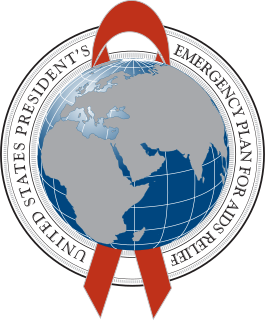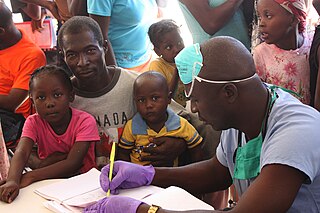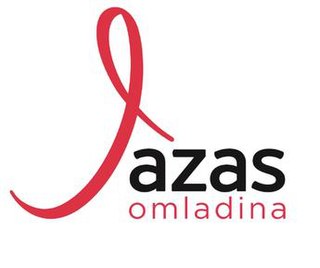Related Research Articles

The United States President's Emergency Plan For AIDS Relief (PEPFAR) is a United States governmental initiative to address the global HIV/AIDS epidemic and help save the lives of those suffering from the disease. Launched by U.S. President George W. Bush in 2003, as of May 2020, PEPFAR has provided about $90 billion in cumulative funding for HIV/AIDS treatment, prevention, and research since its inception, making it the largest global health program focused on a single disease in history until the COVID-19 pandemic. PEPFAR is implemented by a combination of U.S. government agencies in over 50 countries and overseen by the Global AIDS Coordinator at the U.S. Department of State. As of 2021, PEPFAR has saved over 20 million lives, primarily in Sub-Saharan Africa.

Partners In Health (PIH) is an international nonprofit public health organization founded in 1987 by Paul Farmer, Ophelia Dahl, Thomas J. White, Todd McCormack, and Jim Yong Kim.
The Sudanese Red Crescent (SRC) is the biggest and most decentralized and widespread humanitarian organization operating in Sudan. The society developed out of the Sudan branch of the British Red Cross Society and was established in 1956. Upon Sudan's independence in March 1956 received official recognition as an independent National Society following the Sudanese Council of Ministers decree No. 869. The National Society covers nearly the entire country with 15 State branches and several sub-branches/units in the provinces/localities and administrative units, with a nationwide community-based network of 35,000 active volunteers and another 300,000 who can be deployed as need arises. It has well-established working relations with public authorities at federal, state and local levels, and good partnership and collaboration with Movement partners and UN specialized agencies and national and international NGOs working in Sudan.
HIV/AIDS in Eswatini was first reported in 1986 but has since reached epidemic proportions. As of 2016, Eswatini had the highest prevalence of HIV among adults aged 15 to 49 in the world (27.2%).

Mozambique is a country particularly hard-hit by the HIV/AIDS epidemic. According to 2008 UNAIDS estimates, this southeast African nation has the 8th highest HIV rate in the world. With 1,600,000 Mozambicans living with HIV, 990,000 of which are women and children, Mozambique's government realizes that much work must be done to eradicate this infectious disease. To reduce HIV/AIDS within the country, Mozambique has partnered with numerous global organizations to provide its citizens with augmented access to antiretroviral therapy and prevention techniques, such as condom use. A surge toward the treatment and prevention of HIV/AIDS in women and children has additionally aided in Mozambique's aim to fulfill its Millennium Development Goals (MDGs). Nevertheless, HIV/AIDS has made a drastic impact on Mozambique; individual risk behaviors are still greatly influenced by social norms, and much still needs to be done to address the epidemic and provide care and treatment to those in need.
With less than 0.1 percent of the population estimated to be HIV-positive, Bangladesh is a low HIV-prevalence country.
Cases of HIV/AIDS in Peru are considered to have reached the level of a concentrated epidemic. According to a population-based survey conducted in Peru’s 24 largest cities in 2002, adult HIV prevalence was estimated to be less than 1 percent. The survey demonstrated that cases are unevenly distributed in the country, affecting mostly young people between the ages of 25 and 34. As of July 2010, the cumulative reported number of persons infected with HIV was 41,638, and there were 26,566 cases of AIDS, according to the Ministry of Health (MOH), and the male/female ratio for AIDS diagnoses in 2009 was 3.02 to 1. The Joint United Nations Program on HIV/AIDS (UNAIDS) estimates 76,000 Peruvians are HIV-positive, meaning that many people at risk do not know their status. There were 3,300 deaths due to AIDS in Peru in 2007, down from 5,600 deaths in 2005.
HIV/AIDS in Jamaica has a 1.5 percent prevalence of the adult population estimated to be HIV-positive and no significant change over the last five years and therefore Jamaica appears to have stabilized its HIV/AIDS epidemic.
With only 0.2 percent of the adult population estimated to be HIV-positive, Nicaragua has one of the lowest HIV prevalence rates in Central America. HIV was first detected in Nicaragua in 1987, after concentrated epidemics had been reported in other Central American nations. The onset of the epidemic was likely delayed by Nicaragua’s 10-year civil war and the U.S.-led economic blockade, both of which left the country isolated for several years. Relative control over commercial sex work, low infection rates among injecting drug users, and a ban on the commercial sale of blood also slowed HIV transmission. However, the country is at risk of a broader epidemic because of social conditions such as multiple sex partners, gender inequality, and widespread poverty. Many people are unaware of their HIV status and could unwittingly spread the disease. UNAIDS estimates Nicaragua has 7,300 HIV-positive people, nearly half of whom were identified over the past three years.
With 1.28 percent of the adult population estimated by UNAIDS to be HIV-positive in 2006, Papua New Guinea has one of the most serious HIV/AIDS epidemics in the Asia-Pacific subregion. Although this new prevalence rate is significantly lower than the 2005 UNAIDS estimate of 1.8 percent, it is considered to reflect improvements in surveillance rather than a shrinking epidemic. Papua New Guinea accounts for 70 percent of the subregion's HIV cases and is the fourth country to be classified as having a generalized HIV epidemic.

HIV/AIDS was first detected in Canada in 1982. In 2018, there were approximately 62,050 people living with HIV/AIDS in Canada. It was estimated that 8,300 people were living with undiagnosed HIV in 2018. Mortality has decreased due to medical advances against HIV/AIDS, especially highly active antiretroviral therapy (HAART).
Global Health Initiatives (GHIs) are humanitarian initiatives that raise and disburse additional funds for infectious diseases – such as AIDS, tuberculosis, and malaria – for immunizations and for strengthening health systems in developing countries. GHIs classify a type of global initiative, which is defined as an organized effort integrating the involvement of organizations, individuals, and stakeholders around the world to address a global issue.

The affected community is composed of people who are living with HIV and AIDS, plus individuals whose lives are directly influenced by HIV infection. This originally was defined as young to middle aged adults who associate with being gay or bisexual men, and or injection drug users. HIV-affected community is a community that is affected directly or indirectly affected by HIV. These communities are usually influenced by HIV and undertake risky behaviours that lead to a higher chance of HIV infection. To date HIV infection is still one of the leading cause of deaths around the world with an estimate of 36.8 million people diagnosed with HIV by the end of 2017, but there can particular communities that are more vulnerable to HIV infection, these communities include certain races, gender, minorities, and disadvantaged communities. One of the most common communities at risk is the gay community as it is commonly transmitted through unsafe sex. The main factor that contributes to HIV infection within the gay/bisexual community is that gay men do not use protection when performing anal sex or other sexual activities which can lead to a higher risk of HIV infections. Another community will be people diagnosed with mental health issues, such as depression is one of the most common related mental illnesses associated with HIV infection. HIV testing is an essential role in reducing HIV infection within communities as it can lead to prevention and treatment of HIV infections but also helps with early diagnosis of HIV. Educating young people in a community with the knowledge of HIV prevention will be able to help decrease the prevalence within the community. As education is an important source for development in many areas. Research has shown that people more at risk for HIV are part of disenfranchised and inner city populations as drug use and sexually transmitted diseases(STDs) are more prevalent. People with mental illnesses that inhibit making decisions or overlook sexual tendencies are especially at risk for contracting HIV.
Asociación Civil Impacta Salud y Educación is a non-profit organization which promotes public health in the Andean region of Peru.

Yugoslav Youth Association Against AIDS – Youth of JAZAS is non-profit, humanitarian organization committed to HIV prevention and support to the people living with HIV. Ever since its establishment in 1994, it has continuously been implementing projects of peer education, social and psychological support, protection of human rights, promoting voluntary activism, distribution of condoms etc.

Founded in 1999, Alliance India is a non-governmental organisation operating in partnership with civil society, government and communities to support sustained responses to HIV in India that protect rights and improve health. Complementing the Indian national programme, we build capacity, provide technical support and advocate to strengthen the delivery of effective, innovative, community-based HIV programmes to vulnerable populations: sex workers, men who have sex with men (MSM), transgender people, hijras, people who inject drugs (PWID), and people living with HIV.
The Johns Hopkins Center for Communication Programs (CCP) was founded over 30 years ago by Phyllis Tilson Piotrow as a part the Johns Hopkins Bloomberg School of Public Health's department of Health, Behavior, and Society and is located in Baltimore, Maryland, United States.
Infectious diseases within American correctional settings are a concern within the public health sector. The corrections population is susceptible to infectious diseases through exposure to blood and other bodily fluids, drug injection, poor health care, prison overcrowding, demographics, security issues, lack of community support for rehabilitation programs, and high-risk behaviors. The spread of infectious diseases, such as HIV and other sexually transmitted diseases, hepatitis C (HCV), hepatitis B (HBV), and tuberculosis, result largely from needle-sharing, drug use, and consensual and non-consensual sex among prisoners. HIV and hepatitis C need specific attention because of the specific public health concerns and issues they raise.

The Catholic Medical Mission Board (CMMB) is an international, faith-based NGO, providing long-term, co-operative medical and development aid to communities affected by poverty and healthcare issues. It was established in 1912 and officially registered in 1928. CMMB is headquartered in New York City, USA, and currently has country offices in Haiti, Kenya, Peru, South Sudan, and Zambia.
References
- ↑ Works, nGen. "Where We Work". icap.columbia.edu.
- ↑ "Archived copy". Archived from the original on 2012-02-19. Retrieved 2009-11-06.
{{cite web}}: CS1 maint: archived copy as title (link) - ↑ "columbia-icap.org - This website is for sale! - columbia-icap Resources and Information". www.columbia-icap.org.
{{cite web}}: Cite uses generic title (help)
